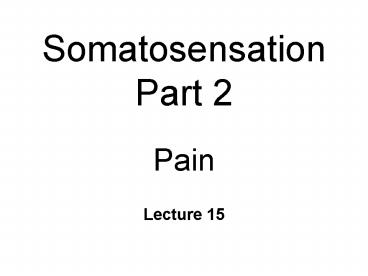Somatosensation Part 2 Pain - PowerPoint PPT Presentation
1 / 27
Title:
Somatosensation Part 2 Pain
Description:
Somatosensation. Part 2. Pain. Lecture 15. Pain ... adaptive: rest injured part. inflammatory response. Histamine, Substance P, prostaglandins, etc. ... – PowerPoint PPT presentation
Number of Views:107
Avg rating:3.0/5.0
Title: Somatosensation Part 2 Pain
1
SomatosensationPart 2Pain
- Lecture 15
2
Pain
- Pain perception
- subjective response...
- to a noxious stimulus
- Sensation nociception
- Nociceptors
- primarily free nerve endings
3
Function of Pain
- Is it adaptive?
- Signals potential tissue damage
- withdraw from stimulus
- Attend to injury
4
Qualities of Pain
- Sharp pain
- acute
- brief, localized skin pain
- produces immediate reaction
- Dull pain
- chronic
- also sweating, palpitations, etc.
5
Qualities of Pain
- Referred pain
- originates in internal organ
- e.g., angina
- perceived in other body areas
- Double pain
- rapid sharp, then persistent dull
- Others
- pricking, burning, itching
6
Acute vs. Chronic Pain
- Acute ---gt withdrawal reflex
- good pain
- Chronic ---gt during healing
- Neuropathy continued pain after healing
- bad pain
- allodynia, hyperalgesia
7
Acute vs. Chronic Pain
- Toxin for substance P receptors
- killed neurons in superficial layer
- eliminated neuropathic pain
- Neurons in lower layers unaffected
- acute pain still functional
- Acute chronic pain different neurons
- Effective treatment for neuropathic
8
Pain Stimulus Thresholds
- Stimulus
- mechanical, thermal, chemical stimuli
- Thresholds
- many factors, difficult to determine
- e.g., qualities, inflammation, swelling,
distribution - sex threshold during ovulation
9
Pain Subjective Factors
- Pain is perception
- more than nociception
- Cognitive emotional factors
- expectation, attention, motivation
- placebo
- meditation
- acupuncture
- stress-induced analgesia
- learned helplessness, sports
10
Hyperalgesia
- Following tissue damage
- Nociceptors are sensitized
- light touch can be painful
- adaptive rest injured part
- inflammatory response
- Histamine, Substance P, prostaglandins, etc.
11
Pain Pathways
- Anterolateral columns
- pain temperature
- spinolthalamic tract
- spinoreticular tract
- spinomesencephalic tract
- analgesia
12
Pain Pathways
- Project to thalamus
- VPL ventroposterior lateral nucleus
- Intralaminar nuclei
- also cortical input
- Primary somatosensory cortex (S1)
13
Spinothalamic Tract
- Sensory neuron
- Ad C fibers
- NTs are coreleased
- Glutamate ---gt fast transmission
- Substance P ---gt slow transmission
- projects into gray matter
- 2d order neuron crosses midline
- at spinal cord
14
Pain
S1
Thalamus - VPL intralaminar
Spinoreticular Tract
Spinothalamic Tract
Reticular Formation
DRG
R
Spinal Cord
15
Analgesia
- Not always adaptive to attend to injury
- fighting, fleeing, mating
- Temporarily decreases...
- nociception
- subjective experience
- Endorphins
- stress-induced analgesia
- acupuncture
- blocked by naloxone
16
DescendingAnalgesiaCircuit
PAG
Spino- mesencephalic tract
R
Spinal Cord
17
Analgesia in Spinal Cord
- Serotonin neuron mediates
- 5-HT directly inhibits
- activates enkephalin neuron
- opioid
- activates GABA neuron
18
Analgesia in Spinal Cord
Presynaptic inhibition
Postsynaptic inhibition
Sub P Glu
19
Analgesia in Spinal Cord
Postsynaptic inhibition
Substance P
20
Melzack-Wall Gate Theory of Pain
- Why it feels better to rub an injury
- Modulation of pain signals
- by touch pathways
- Gate neuron in spinal cord
- Substantia Gelatinosa
- inhibited by C fibers (pain)
- activated by Ab fibers (touch)
- pain signals in projection neurons
21
Melzack-Wall Gate Theory of Pain
Spinothalamic Tract
22
Nonopioid Analgesia
- Naloxone bocks opioid-mediated analgesia
- Intermittent shock ---gt no analgesia
- short, continued shock ---gt analgesia
- Suggests nonopioid analgesic systems
23
Nonopioid Analgesia
- NMDA (N-methyl-D-aspartate)
- Glutamate receptor
- MK-801 - NMDA antagonist
- MK-801 Naloxone
- blocked analgesia in male rats
- attenuated analgesia in female rats
24
Nonopioid Analgesia
- Estrogen-modulated analgesia
- Ovariectomized female rats
- nonopioid analgesia
- estrogen or progesterone ---gt analgesia
25
Nonopioid Analgesia
- Potential new analgesic drug
- opiates have undesirable side effects
- Cholinergic-mediated analgesia
- ABT-594 cholinergic agonist
- Comparable to opiate analgesia
26
Nonopioid Analgesia
- Developed from frog skin toxin
- epibetadine
- too toxic for humans
- found ACh agonist with similar structure
- Altered ---gt ABT-594
27
Temperature
- Thermal sensations
- regulation of body temperature
- changes in skin temperature
- Mainly free nerve endings
- but other receptors also
- cold receptors near surface
- heat receptors at deeper levels































